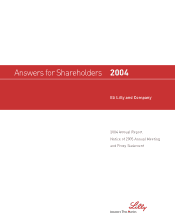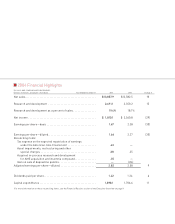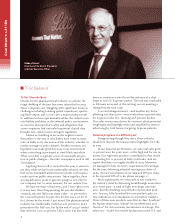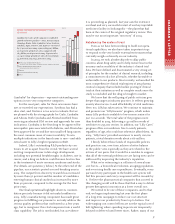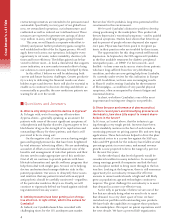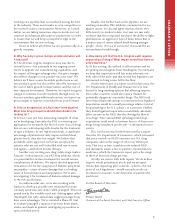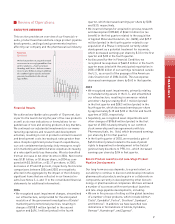Eli Lilly 2004 Annual Report Download - page 7
Download and view the complete annual report
Please find page 7 of the 2004 Eli Lilly annual report below. You can navigate through the pages in the report by either clicking on the pages listed below, or by using the keyword search tool below to find specific information within the annual report.
CHAIRMAN’S LETTER
5
working on a pipeline that is considered among the best
in the industry. These assets make us very competitive in
the current business environment. Moreover, as I noted
earlier, we are taking numerous steps to shrink our cost
structure and dramatically improve productivity in order
to ensure that we will keep a competitive edge in the
environment that we see evolving.
I have to believe all of these factors position Lilly as a
growth company.
Q: Why has Lilly’s gross margin eroded and when will
it rebound?
A: The decrease in gross margin in 2004 was due to
several factors—but primarily to our ongoing invest-
ments to upgrade our manufacturing capabilities and
the impact of foreign exchange rates. Our gross margin
also refl ects changes in our product mix over time. We
believe we’ll have a more favorable product mix as our
new products grow, but this will be offset by increases in
the cost of labor, growth in depreciation, and the cost of
new capacity investments. Therefore, we expect our gross
margin to continue to erode modestly through 2005. As
our new products gain additional traction, we expect our
gross margin to improve somewhat from 2006 forward.
Q: Give us an appraisal of Lilly’s near-term pipeline.
What new drug prospects should shareholders be
looking for?
A: Let me cover just four interesting examples of what
we’re developing. Currently, the FDA is reviewing our
application for exenatide, the fi rst of a new class of drugs
that we are co-developing with Amylin for the treatment
of type 2 diabetes. In our registration trials, a signifi cant
percentage of patients not only improved their blood
glucose levels, they also lost weight. We believe that
exenatide, when approved, will create an option for
patients who are not well controlled with one or more
oral agents—and before insulin therapy.
Another very exciting new drug in late-stage trials is
Arxxant™ (ruboxistaurin), our PKC-beta inhibitor, which
is a potential fi rst-in-class treatment for several serious
complications of diabetes. We expect the fi rst approved
indication to be for the symptoms of diabetic peripheral
neuropathy—a type of nerve damage that is a leading
cause of foot ulceration and amputations. We’re also
investigating it for treatment of diabetes-related damage
to the eyes and kidneys.
In cardiovascular care, we’re also working with
Sankyo to develop a possible new treatment for acute
coronary syndrome and stroke called prasugrel. This com-
pound works like a widely used anti-clotting agent called
clopidogrel, but early animal data suggest prasugrel may
have some advantages. We’ve initiated a Phase III trial
to evaluate prasugrel’s capacity to prevent heart attack,
stroke, and death in patients undergoing a procedure to
open a blocked artery.
Finally, a bit further back in the pipeline, we are
working on another PKC inhibitor, enzastaurin, for use
against cancer. It is an oral agent that has shown very
little toxicity in studies to date. Last year, we saw early
evidence that this compound may have the ability to fi ght
glioblastoma, an aggressive type of brain tumor that is
a major cause of cancer-related death among younger
people—those 18 to 54. If successful, this would be an
extraordinary breakthrough.
Q: How likely is it that the U.S. Congress will legalize
importation of drugs? What impact would that have on
Lilly’s business?
A: At this writing, the outlook is still uncertain and we
are getting mixed signals from Washington. On one hand,
we hear that importation still has many advocates on
both sides of the aisle, and that several key legislators are
determined to bring a new bill to the fl oor.
On the other hand, in a report issued in late 2004, the
U.S. Department of Health and Human Services reaf-
fi rmed its long-standing opinion that allowing imports
from other countries would also open a channel for
potentially dangerous counterfeit drugs. The HHS task
force found that total savings to consumers from legalized
importation would be a small percentage relative to total
drug spending in the U.S. (about 1 to 2 percent). Further,
they found legalized importation would likely adversely
affect incentives for R&D, thereby slowing the fl ow of
new drugs. Since annual R&D spending would drop,
importation could result in between four to 18 fewer new
drugs being introduced per decade—a substantial cost to
society.
This conclusion was further buttressed by a report
from the U.S. Department of Commerce, which estimated
that price controls in OECD countries cost U.S. drug
companies sales in the range of $18 to $27 billion per
year. That loss, in turn, translates into reduced R&D,
and ultimately means a loss to patients of potential new
medicines, which the Commerce report put in the range
of three or four new drugs per year.
At Lilly, we concur with both reports. We do believe
imports would put patients at risk and we are quite
certain that importing price controls—which is the real
point of such legislation—would seriously erode our
incentives to innovate, to the detriment of patients the
world over.
For the Board of Directors,
Sidney Taurel
Chairman of the Board, President, and Chief Executive Offi cer

